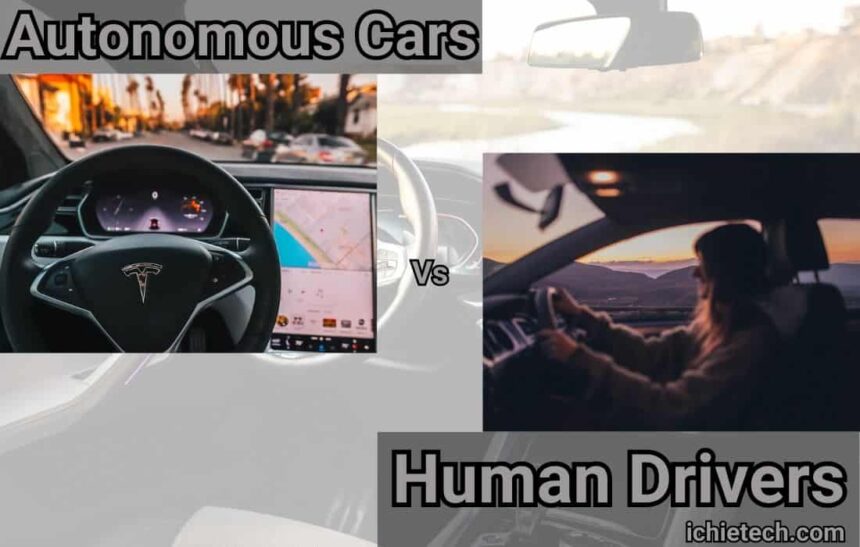Autonomous vehicles have been a hot issue for some years, with many expecting that they would ultimately replace human drivers on the road. While the technology is still in its early stages, it is evident that self-driving cars have the potential to change the way we travel and the debate between autonomous cars vs human drivers continues.
One of the primary benefits of self-driving cars is their capacity to remove human error, which is responsible for a considerable percentage of road accidents. Moreover, self-driving cars can optimize driving circumstances, decreasing traffic congestion and increasing fuel economy. Some, on the other hand, are concerned about the possible loss of jobs for human drivers, as well as the ethical implications of programming autonomous vehicles in situations when human life is at stake.
Notwithstanding the hurdles and concerns, the development of self-driving automobiles is moving quickly. Autonomous vehicles are expected to be prevalent on the road by 2030, with experts suggesting that they might cut traffic deaths by up to 90%. It remains to be seen if autonomous cars will totally replace human drivers, and end the debate between autonomous cars vs human drivers. but it is obvious that they will play an increasingly crucial part in the future of driving.
Autonomous Cars

1. Definition
Autonomous vehicles are vehicles outfitted with advanced technology that allows them to navigate and function without the need for human involvement. They sense their environment and make judgments about speed, direction, and stopping using sensors, cameras, and GPS. Autonomous vehicles are classed according to their level of autonomy, which ranges from Level 0, which requires complete human control, to Level 5, which requires no human involvement. The development of self-driving cars has the potential to change the automobile industry and the way we travel.
Types of Autonomous Cars
According to the Society of Automotive Engineers (SAE), there are six levels of autonomy for self-driving cars:
- Level 0 – No Automation: With no automation, the driver maintains complete control of the vehicle at all times.
- Level 1 – Driving Assistance: The car has certain automated capabilities, such as cruise control or lane departure warning, but the driver is still in charge.
- Level 2 – Partial Automation: The vehicle may manage steering as well as acceleration and deceleration, but the driver must be ready to take control at any time.
- Level 3 – Conditional Automation: In some situations, like on the highway, the vehicle can perform most driving functions, but the driver must still be ready to take over if necessary.
- Level 4 – High Automation: The vehicle may run autonomously under certain settings, such as inside a specific region or under specific weather conditions, but it still requires a human driver to take control in some instances.
- Level 5 – Complete Automation: The vehicle can undertake all driving responsibilities in any scenario without requiring the assistance of a human driver.
2. Advantages of autonomous cars
- Improved Safety: Autonomous vehicles monitor their surroundings and make judgments using modern sensors, cameras, and algorithms, which can significantly minimize the chance of accidents caused by human error.
- Reduced Traffic Congestion: Self-driving cars may interact with one another as well as with traffic management systems to optimize routes and avoid congestion, resulting in smoother traffic flow and shorter travel times.
- Increased Fuel Efficiency: Autonomous vehicles may run more efficiently by altering their speed and route in response to real-time traffic circumstances, resulting in lower fuel consumption and emissions.
- Enhanced Mobility: Self-driving cars can provide mobility for people who are unable to drive due to age or disability, allowing them to travel securely and freely.
- Improved Productivity: Autonomous vehicles can free up time for drivers by allowing them to do other things like work or rest while the vehicle drives.
- Cost Savings: Autonomous automobiles have the potential to cut transportation costs by eliminating the need for human drivers, lowering insurance costs, and improving vehicle lifespan owing to improved driving behaviour.
3. The technology behind autonomous cars
To run without human involvement, autonomous vehicles rely on a range of technology. They assess their environment and identify impediments using sensors like lidar, radar, and cameras. Onboard computers employ artificial intelligence and machine learning algorithms to make judgments regarding speed, direction, and stopping based on the data collected by these sensors. GPS and mapping technology is also used by self-driving automobiles to navigate and avoid hazards. As the technology behind self-driving cars advances, we should expect to see more sophisticated features and greater road safety.
4. Current state and future of autonomous cars
Autonomous cars are still in their infancy, with limited availability and exorbitant prices. Nonetheless, technology is fast evolving, and big automakers and technology firms are significantly investing in its advancement. Autonomous vehicles are expected to become more widespread on our roads in the next years, altering the way we travel.
5. Concerns and limitations of autonomous cars
Notwithstanding the potential benefits, there are issues and constraints associated with the development and deployment of self-driving automobiles. They include concerns about safety, cybersecurity, ethical implications, and the possible loss of human drivers’ jobs. Nevertheless, the cost of creating and manufacturing self-driving cars remains considerable, restricting their accessibility to the general population.
“Want to learn more about the future of driving? Check out our article on autonomous cars.”
Human Drivers

For many years, human drivers have been the dominant mode of transportation, but their limitations and hazards are becoming more evident as technology advances. While human drivers will most certainly continue to play an important role in transportation, the importance of self-driving cars is growing.
1. Advantages of Human Drivers
- Flexibility and Adaptability: Human drivers can swiftly react to changing road circumstances, such as unforeseen obstructions or weather changes, and alter their driving appropriately.
- Judgment and Decision-making: Human drivers may make complicated judgments based on their experience, training, and intuition, such as when to yield to pedestrians or how to traverse a challenging intersection.
- Emotional Intelligence: Human drivers have the ability to interact and sympathize with passengers and other drivers, which is vital for maintaining a safe and polite driving environment.
- Managing Emergencies: In an emergency, human drivers may respond swiftly and creatively, such as swerving to avoid a collision or doing CPR on a passenger.
- Human Touch: Human drivers may provide a human touch to the driving experience by giving local information, and instructions, or simply engaging in conversation.
- Adaptability to Non-standard Situations: Human drivers can negotiate odd or unexpected conditions, such as when road construction, traffic accidents, or emergency vehicles cause detours or modify traffic patterns.
2. Limitations of human drivers
Human drivers have a variety of restrictions and dangers, such as attention, exhaustion, and human mistake, all of which can result in accidents and traffic congestion. Moreover, humans have a limited capacity for information processing, making it difficult to make complicated judgments quickly and accurately while driving.
3. Factors that affect driving ability
Physical and mental health, age, weariness, attention, and alcohol or drug use are all variables that might impair driving abilities. External circumstances like road and weather conditions, traffic congestion, and unexpected occurrences can all have an effect on one’s ability to drive. Drivers must be aware of these variables and take necessary precautions to preserve safe driving habits.
4. Importance of driver education and training
Driver education and training are critical for promoting safe and responsible driving habits. Drivers may learn how to detect and respond to possible risks, manage complicated traffic situations, and prevent distractions and impaired driving with proper education and training. To preserve safe driving behaviours, all drivers must receive continual instruction and training.
Autonomous Cars vs Human Drivers
| Autonomous Cars | Human Drivers | |
| Safety | Advanced sensors and algorithms can greatly reduce the risk of accidents caused by human error | Can quickly adapt to changing road conditions and make complex decisions based on experience and intuition |
| Traffic Congestion | Can communicate with other autonomous cars and traffic management systems to optimize routes and avoid congestion, resulting in smoother traffic flow and reduced travel times | May be more prone to causing traffic congestion due to human error or lack of coordination |
| Fuel Efficiency | Can operate more efficiently by adjusting speed and route based on real-time traffic conditions, leading to reduced fuel consumption and emissions | May not always prioritize fuel efficiency or may be less efficient due to human error |
| Mobility | Can provide mobility for individuals who are unable to drive due to age or disability, allowing them to travel safely and independently | Some individuals may prefer or require a human driver due to personal preferences or medical needs |
| Productivity | Can free up time for passengers by allowing them to engage in other activities, such as working or relaxing, while the vehicle handles the driving | Human drivers may provide a more personalized or social driving experience, which can be valuable for certain passengers |
| Adaptability | Maybe less adaptable to unexpected or non-standard situations, such as road closures or detours | Can quickly adapt to changing road conditions and navigate complex or unexpected situations |
| Decision-making | May rely on algorithms or pre-programmed instructions, which may not always be able to account for complex or subjective factors | Can make complex decisions based on experience, training, and intuition |
| Emotional Intelligence | May lack the ability to communicate and empathize with passengers and other drivers | Can communicate and empathize with passengers and other drivers, which can be important for maintaining a safe and respectful driving environment |
| Maintenance | May require specialized maintenance or repair due to complex sensors and algorithms | May be easier and more cost-effective to maintain and repair |
| Cost | May be more expensive due to advanced technology and sensors | May be less expensive due to the lower cost of human drivers and vehicles |
Conclusion
To summarize, the rise of self-driving cars has tremendous potential to improve the transportation business and boost road safety. Yet, it is critical to address possible issues and limits of self-driving cars while acknowledging the ongoing role of human drivers in the transportation industry. We can improve our driving habits and keep the roads safe by continuing our driver education and training. As we look to the future of driving, it is critical to address safety and ethical concerns in the development and deployment of self-driving cars. Ultimately, the adoption of self-driving vehicles has the potential to transform the way we travel, but we must be watchful and proactive in resolving any difficulties that may develop. I would like to know what your take is, in the comment section about the ongoing autonomous cars vs human drivers debate.










